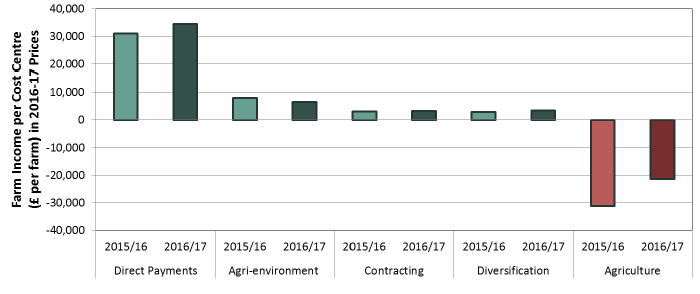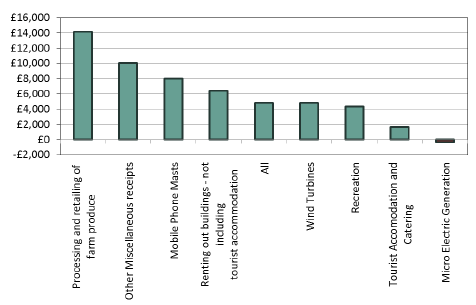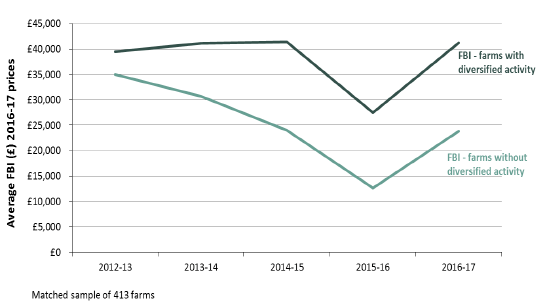Scottish farm business income: annual estimates 2016-2017
This publication provides estimates of average farm business incomes for the accounting year 2016-17, which relates to the 2016 crop year. For the most recent data, visit the Scottish farm business income (FBI) collection page below.
3. Comparison of Profitability
3.1 Cost centres (Table 7)
The purpose of cost centre analysis is to identify the contribution of different sources of income within the business to the overall business’s profit or loss. Although referred to as ‘cost centres’ it is worth noting that these parts of the business are not just costs, they also generate income. All inputs and outputs have been counted against one of five cost centres: agricultural; agri-environment (land management to support environmental objectives); diversification; agricultural contracting (off-farm use of farm business resources); and income from the direct payments scheme (costs could be incurred against this centre if, for example, accountants are hired to manage claims).
Figure 6 below shows the overall average income from each cost centre in 2015-16 and 2016-17. In both years, losses were accumulated against farming activity (the agricultural cost centre).
The average loss from agricultural farming activities decreased between 2015-16 and 2016-17 to £21,300. This loss from agricultural activities was offset by income from diversification, contracting and agri-environment activities. However, the profitability of the average Scottish farm business in the FBS is heavily reliant on income from the Direct Payment Schemes.
Figure 6: Farm Business Income by cost centre

The average income to Scottish farm businesses in the survey from direct payments was £34,500 in 2016-17, an increase of 11 per cent on the previous year. There was an 18 per cent decrease in the value derived from agri-environment schemes to an average of £6,500. Contracting increased six per cent in the latest year, with this activity generating an average of £3,300. Diversified activities generated £3,400 on average, a 22 per cent increase since 2015-16. Despite the low average income from diversified activities, farms engaged in such activities reported notably higher incomes than non-diversified farms on average.
3.2 Diversified activities (Tables 8, 9)
Some farms receive additional income from diversified activities and figure 7 shows the main activities undertaken and the average income from each in 2016-17. Of farms engaged in diversified activities, the overall average income from such activities was £4,900. The most common diversified activity was renting out buildings (for uses other than tourist accommodation) which accounted for 45 per cent of activities. Processing and retailing of farm produce was the activity that generated the greatest income, with an average income of £14,200.
Figure 7: Average income from diversified activities in 2016-17

The unmatched sample shows that average income from diversified activities had increased by ten per cent in the last year. The largest increase in number of activities in the sample was seen in wind turbines, with the average income from this activity being £4,800 in 2016-17. Micro electric generation, which includes renewable energy other than wind turbines (e.g. solar panels, biomass boilers and hydro-electric), was the only activity to make a loss, with the average loss of income being £400. Losses in this category have reduced since 2015-16 due to a fall in start-up costs and lower depreciation costs.
Figure 8 shows, from a five year matched sample (comparing the same farms each year), the average FBI of those farms engaged in any diversified activity and those with no diversified activities. Diversification is assessed over, at most, a five-year period to allow for a reasonable matched sample size. Note that the matched sample is un-weighted and therefore describes sample averages only.
Figure 8: Comparison of average income of farms with and without diversified activities (in 5 year matched sample)

The average difference in FBI between diversified and non-diversified farms was around £17,400.
For farms engaged in diversifies activities in the five year matched sample, the average FBI was £41,200, which was 50 per cent higher than the previous year. The average income from the diversified activities for these farms was £6,400, a 12 per cent increase from the previous year.
The average FBI for farms not engaged in diversified activity, in the five year matched sample, was £23,800, an increase of 88 per cent over the last year.
Contact
There is a problem
Thanks for your feedback